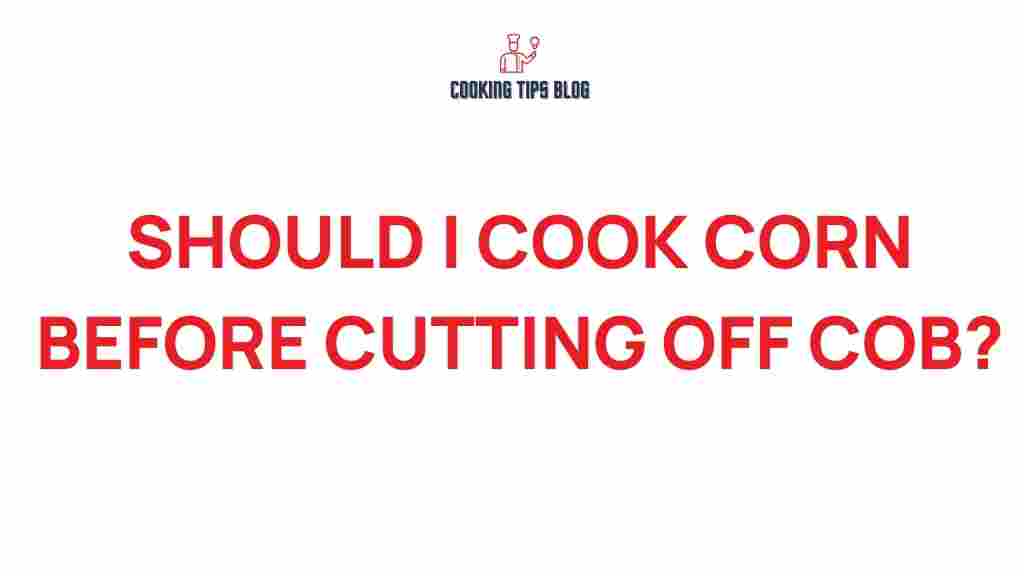Should You Cook Corn Before Cutting It Off the Cob? Discover the Best Method!
Corn is a versatile vegetable that can elevate many dishes, from salads to salsas. However, a common question arises when preparing fresh corn: should you cook it before cutting it off the cob? This article will delve into the best methods for preparing corn, focusing on corn cooking techniques that maximize flavor and texture. Whether you’re a culinary novice or a seasoned chef, understanding how to handle corn can enhance your cooking experience and improve your dishes.
The Benefits of Cooking Corn
To answer the initial question, cooking corn before cutting it off the cob can yield numerous benefits. Here are a few reasons why you might want to consider cooking your corn:
- Enhanced Flavor: Cooking corn releases its natural sugars, resulting in a sweeter taste.
- Improved Texture: Cooking can soften the kernels, making them easier to cut off the cob.
- Better Digestion: Cooking may help break down the fibers in corn, making it easier on your stomach.
When to Cut Corn Off the Cob
While cooking corn before cutting it off the cob is often recommended, there are situations where cutting it raw can be beneficial. For instance:
- When using fresh corn in salads, cutting it raw maintains its crunch.
- Raw corn can be mixed into salsas for a fresher flavor profile.
Ultimately, the choice between cooking and cutting raw depends on the desired outcome of your dish. However, in most cases, corn cooking before cutting will enhance the overall flavor and texture.
Step-by-Step Process: Cooking Corn Before Cutting It Off the Cob
Now that we have established the benefits of cooking corn, let’s go through the step-by-step process to ensure you achieve the best results.
Step 1: Selecting Fresh Corn
Start by selecting high-quality corn. Look for:
- Bright Green Husks: The husks should be tightly wrapped around the corn.
- Plump Kernels: Give the cob a gentle squeeze; it should feel firm, not soft.
- Silk Color: The silk should be golden and slightly sticky, indicating freshness.
Step 2: Preparing the Corn
Before cooking, prepare the corn by following these steps:
- Remove the husks and silk carefully.
- Rinse the corn under cold water to remove any dirt.
- Snap off any excess stem at the end of the cob.
Step 3: Cooking Methods
There are several effective methods for corn cooking. Each method imparts a unique flavor and texture to the corn:
Boiling Corn
- Fill a large pot with water and bring it to a boil.
- Add a pinch of salt to the water.
- Carefully add the corn cobs to the boiling water.
- Boil for 4-6 minutes, depending on the size of the cobs.
- Remove the corn and let it cool for a few minutes before cutting.
Grilling Corn
- Preheat your grill to medium-high heat.
- Husk the corn, or alternatively, soak it in water for 30 minutes before grilling.
- Place the corn directly on the grill and cook for 10-15 minutes, turning occasionally.
- Remove from the grill and allow it to cool slightly before cutting.
Steaming Corn
- Fill a pot with a small amount of water and insert a steamer basket.
- Bring the water to a boil.
- Add the corn to the steamer basket, cover, and steam for 5-7 minutes.
- Remove from the steamer and let it cool before cutting.
Step 4: Cutting Corn Off the Cob
After cooking, it’s time to cut the corn off the cob:
- Place the cob vertically in a bowl or on a cutting board.
- Using a sharp knife, cut downward along the cob, removing the kernels.
- Make sure to cut close to the cob to avoid wasting any kernels.
Troubleshooting Tips for Cooking Corn
Even with the best intentions, cooking corn can sometimes go awry. Here are some troubleshooting tips:
- Corn Tastes Tough: Ensure you are cooking for the right amount of time. Overcooking can lead to tough kernels.
- Insufficient Flavor: If boiled or steamed corn lacks flavor, consider adding a touch of butter, salt, or herbs after cooking.
- Uneven Cooking: When grilling, rotate the corn regularly to ensure even cooking.
Conclusion
In summary, cooking corn before cutting it off the cob is generally the best method to enhance the flavor and texture of this delicious vegetable. Various cooking methods, such as boiling, grilling, and steaming, can be used to achieve the desired results. Remember to select fresh corn, prepare it properly, and follow the cooking instructions carefully.
Whether you’re incorporating it into a salad, adding it to a salsa, or enjoying it as a side dish, the right corn cooking technique can make all the difference. For more cooking tips and recipes, check out our cooking resources. Happy cooking!
For more information on corn varieties and their uses, visit this agricultural guide.
This article is in the category Tools and created by Cookingtipsblog Team
